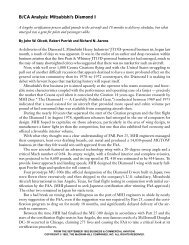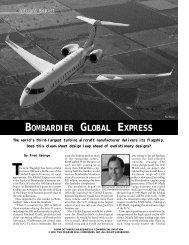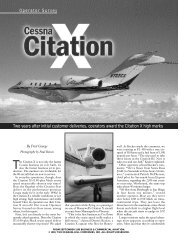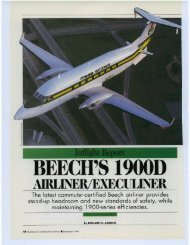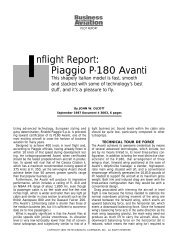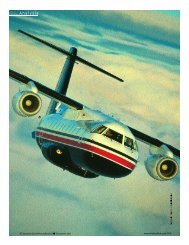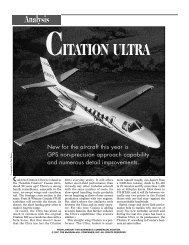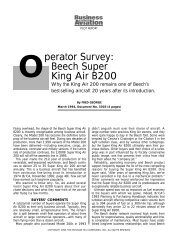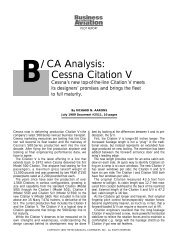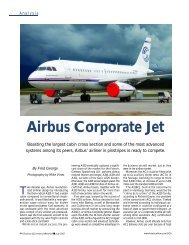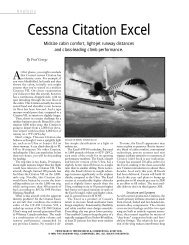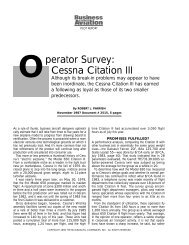Piaggio P180 Avanti
Piaggio P180 Avanti
Piaggio P180 Avanti
You also want an ePaper? Increase the reach of your titles
YUMPU automatically turns print PDFs into web optimized ePapers that Google loves.
PILOT REPORT<br />
O<br />
perator Survey:<br />
<strong>Piaggio</strong> <strong>P180</strong> <strong>Avanti</strong><br />
Turbofan-like performance, miserly fuel<br />
consumption and excellent passenger comfort<br />
don’t guarantee initial sales success.<br />
By FRED GEORGE<br />
June 1994, Document No. 3000 (4 pages)<br />
Rinaldo <strong>Piaggio</strong> S.p.A. is the builder of an airplane that<br />
is legitimately ranked among the most technically<br />
advanced turboprop business aircraft in the world. If<br />
there were any doubt as to this reality, one needs only<br />
to pick up B/CA’s Planning & Purchasing Handbook<br />
and thumb through the business aircraft charts.<br />
The numbers in those tables tell the story. The <strong>Piaggio</strong><br />
<strong>P180</strong> <strong>Avanti</strong>’s 392 KTAS maximum cruise speed is<br />
more than 50 knots faster than the closest turboprop<br />
competitor, and it’s 100 knots faster than many others.<br />
The <strong>Avanti</strong>’s speed and altitude performance are more<br />
comparable to the Cessna Citation II’s numbers than to<br />
any other turboprop’s. The <strong>Avanti</strong>, however, offers passengers<br />
a cabin with a cross section that’s nearly identical<br />
to the Dassault Falcon 50’s, and interior sound levels<br />
that are among the lowest ever achieved in business aircraft<br />
regardless of engine design. It also weighs thousands<br />
of pounds less than any other business aircraft with<br />
comparable interior space.<br />
The <strong>Avanti</strong> might seem to be more in the league of<br />
turbofan business aircraft than it is in the turboprop<br />
class; that is, until the fuel truck finishes topping off the<br />
tanks. At that point the <strong>P180</strong> is in a league of its own,<br />
because it burns less than half the fuel of many fanjet<br />
competitors—especially those having comparable<br />
cabin volume. Indeed, no other twin turboprop listed in<br />
our May Handbook can beat the <strong>Avanti</strong>’s fuel miserliness,<br />
except for the 214-knot Partenavia Victor.<br />
<strong>Piaggio</strong> didn’t achieve this excellent blend of performance,<br />
comfort and economy by using exotic materials<br />
or unproven engines, or by cutting corners on systems.<br />
Instead, the firm launched an all-out assault on airframe<br />
drag and weight, using some of the most advanced<br />
design computers and wind tunnels in the aerodynamic<br />
engineering arsenal. <strong>Piaggio</strong> deliberately chose lowrisk,<br />
proven-technology engines, avionics and composite<br />
applications to make the aircraft a model of<br />
dependability.<br />
<strong>P180</strong> DEVELOPMENT HISTORY<br />
The research and development campaign began in<br />
1979, long before Rinaldo <strong>Piaggio</strong> announced the<br />
<strong>P180</strong> program at the October 1983 NBAA Convention.<br />
By the time the aircraft received type certification<br />
from the Registro Aeronautico Italiano and the FAA in<br />
1990, the firm had invested $150 million and 11 years<br />
in the program, including more than 4,600 hours of<br />
wind-tunnel testing.<br />
<strong>Piaggio</strong>’s <strong>P180</strong> sales record, however, has been less<br />
than spectacular.<br />
A U.S. customer took delivery of the first production<br />
aircraft, Serial Number 1004, in October 1990.<br />
Buoyed by the initial excitement of the business aircraft<br />
market, the firm started building one aircraft per month.<br />
By mid 1992, however, sales slowed and the production<br />
rate fell. Serial Numbers 1029 and 1030 will roll<br />
off the assembly line in the middle of this year.<br />
Here is an aircraft that the trade press loves to praise.<br />
COPYRIGHT 1995 THE MCGRAW-HILL COMPANIES, INC. ALL RIGHTS RESERVED
P ilot<br />
Report<br />
Virtually every aviation publication has raved about the<br />
<strong>Avanti</strong>’s performance, efficiency and docile handling<br />
characteristics, as well as its cabin accommodations,<br />
lack of vibration and exceptionally low noise levels.<br />
So, why have so few <strong>Avanti</strong>s been sold? It is logical<br />
to wonder if <strong>Piaggio</strong> will ever recoup its investment, let<br />
alone make a profit on the <strong>P180</strong> venture.<br />
In an attempt to discover why more customers haven’t<br />
signed sales contracts (among other things), we decided<br />
to ask U.S. and European operators about their<br />
experiences with the aircraft.<br />
OPERATORS’ COMMENTS<br />
With only 14 aircraft in service worldwide, including<br />
the North American factory demonstrator, we had to be<br />
careful not to jump to hasty conclusions based on our<br />
small sample size. Patterns to the responses did emerge<br />
as the interviews progressed, however.<br />
The North American operators—all but one of whom<br />
are successful entrepreneurs—wanted to be at what<br />
they perceived as the cutting edge of turboprop business<br />
aircraft technology. “Someone had to buy the first<br />
CD player, and someone had to buy the first <strong>Avanti</strong>,”<br />
explained one operator. We heard similar comments<br />
from other North American operators, most of whom<br />
operate the <strong>Avanti</strong> as their sole business aircraft.<br />
One North American buyer sold his Sabreliner 65<br />
when he acquired the <strong>P180</strong>. Another operator, upgrading<br />
from a Beech Super King Air 200, briefly eyed the<br />
Beech Starship 2000A but then opted for the <strong>Avanti</strong>—<br />
partly because of its 57-knot maximum speed advantage.<br />
In contrast, the Europeans had somewhat more pragmatic<br />
reasons for buying the <strong>Avanti</strong> <strong>P180</strong>. They are<br />
mainly multiple aircraft operators with fleets of charter aircraft,<br />
and for them, overall operating economy vies with<br />
advanced technology as the top attraction to the aircraft.<br />
Performance and quality were high on the list of priorities<br />
expressed by all <strong>Avanti</strong> operators. We heard plenty<br />
of praise for <strong>Piaggio</strong>’s high standards of fit and finish<br />
from both sides of the Atlantic. They frequently mentioned<br />
the Citation II, the Beechjet 400A and the Learjet<br />
35A as their second choice. A few also considered<br />
Beech Super King Air 200s, 300s and 350s prior to<br />
deciding on the <strong>Avanti</strong>.<br />
Pilots commended the <strong>Avanti</strong> for its stability, lithe handling<br />
qualities and exceptionally low cockpit noise<br />
level. They specifically mentioned the aircraft’s avionics<br />
and engine reliability.<br />
“Collins in the panel; Pratt & Whitney on the<br />
engines,” one pilot said concisely, as if to imply he<br />
could ask for no more.<br />
The average trip profile flown by most North American<br />
operators—300 to 350 miles—closely resembles<br />
the typical turboprop flight. In contrast to other turboprops,<br />
though, such trips take only 50 minutes to one<br />
hour. One operator quipped, “My chairman complains<br />
now he doesn’t have time to open his briefcase<br />
between takeoff and landing.”<br />
On longer trips, North American operators report the<br />
aircraft cruises at 365 to 385 knots. The European<br />
respondents reported cruise speeds of 340 to 360<br />
KTAS, with some saying they push the aircraft up to<br />
380 knots on longer flights.<br />
Most operators told us that distances of 1,000 to<br />
1,100 miles are the longest they are comfortable flying,<br />
mainly because of the need to carry enough fuel for<br />
prolonged low altitude cruising mandated by ATC, and<br />
also for IFR weather reserves. Under optimum conditions,<br />
however, they would stretch the flight plan to<br />
1,250 to 1,400 miles, operators said, while cruising at<br />
FL 370 to FL 390—data which confirm the manufacturer’s<br />
advertised performance numbers.<br />
“The <strong>Avanti</strong> meets or exceeds our performance<br />
expectations,” proclaimed one chief pilot in the United<br />
States, essentially summing up the comments we heard<br />
from other <strong>Avanti</strong> operators.<br />
The aircraft’s high-speed, high-altitude performance is<br />
accompanied by excellent fuel efficiency. Operators<br />
report fuel flows of 550 pph at 350 knots and 600 pph<br />
at 360 to 385 knots. Even at its maximum cruise speed<br />
of 392 KTAS at FL 280, the <strong>Avanti</strong> burns less than 800<br />
pph, according to the aircraft flight manual. Fuel efficiency<br />
is more than a laudable technical achievement<br />
to Europeans and others outside of the United States.<br />
It’s a matter of economic necessity.<br />
<strong>Avanti</strong> operators fly 400 to 500 hours per year on<br />
average, although there is plenty of spread from the<br />
median. Most fly the aircraft with two pilots, but some<br />
non-commercial operators occasionally use the copilot’s<br />
seat to accommodate an extra passenger.<br />
The average passenger load is four to five people,<br />
but it is not unusual for <strong>Avanti</strong> operators to fill all the<br />
seats in the cabin because of the ample space. One<br />
North American FAR Part 91 operator, for example,<br />
said that his firm seldom flies the aircraft with less than<br />
six passengers on board.<br />
Operators also like the aircraft’s 44-cubic-foot, aft<br />
external luggage compartment with its left side rear<br />
door. This configuration permits baggage to be loaded<br />
and unloaded with the right engine operating, a great<br />
benefit during quick turnarounds.<br />
Some Europeans also considered the <strong>Avanti</strong>’s greenplanet<br />
ecological appeal one of its best features, particularly<br />
in the charter market. The <strong>P180</strong> simply consumes<br />
far less fossil fuel and emits a fraction of the combustion<br />
pollutants of most other business aircraft, giving it a<br />
competitive edge in the increasingly environmentally<br />
aware European air taxi market.<br />
COPYRIGHT 1995 THE MCGRAW-HILL COMPANIES, INC. ALL RIGHTS RESERVED
P ilot<br />
Report<br />
Passengers like the <strong>P180</strong>’s interior spaciousness, lack<br />
of vibration and low sound level. Many operators said<br />
that the <strong>Avanti</strong> is at least as quiet as most turbofan business<br />
aircraft and clearly without equal among turboprops.<br />
One claimed that the <strong>P180</strong> is “the quietest<br />
aircraft we’ve ever flown.”<br />
When comparing the <strong>Avanti</strong> to other aircraft, one<br />
East European charter operator said, “Our competition<br />
operates a [conventional turboprop], but our <strong>P180</strong> is<br />
the aircraft that 80 percent of the clients prefer.”<br />
NEEDED IMPROVEMENTS<br />
Almost every clean-sheet design aircraft goes through<br />
some growing pains, and the <strong>Avanti</strong> is no exception.<br />
<strong>Piaggio</strong>, though, has established an overall superb reputation<br />
for <strong>P180</strong> product support in North America and<br />
Europe, according to operator comments. One German<br />
operator singled out Fritz Winkler of Winair in<br />
Flughafen, Germany, commending him for his outstanding<br />
after-sales support.<br />
Specifically, operators griped about the lack of<br />
range/payload flexibility in early models. Those aircraft<br />
could carry people or fuel, but not as much as was<br />
needed of both on the same trip. The <strong>P180</strong> originally<br />
was certified with a 10,900-pound maximum ramp<br />
weight and a MGTOW of 10,810 pounds. With a<br />
BOW of 7,700 pounds, the payload with a 2,650-<br />
pound maximum fuel load was a scant 550 pounds,<br />
equivalent to approximately three passengers with light<br />
baggage.<br />
Later, a paperwork change bumped the MGTOW up<br />
390 pounds. <strong>Piaggio</strong> now offers Service Bulletin 80-<br />
0023, which beefs up the landing gear structure and<br />
attachment points, among other changes, thereby<br />
allowing the MGTOW to be increased to 11,550<br />
pounds. This change more than doubles the payload<br />
with maximum fuel as compared to the original<br />
MGTOW. The aircraft can now accommodate six passengers,<br />
each with a baggage allowance of more than<br />
30 pounds. The range/payload flexibility of SB 80-<br />
0023 should put an end to operator complaints about<br />
this problem.<br />
Many operators told B/CA that they are becoming<br />
impatient waiting for the anti-lock brake system (ABS) to<br />
be certified. ABS brakes are scheduled to be part of SB<br />
80-0023, and <strong>Piaggio</strong> plans to have the system certified<br />
by the end of this year.<br />
Earlier models also experienced frequent nosewheel<br />
steering malfunctions. <strong>Piaggio</strong> responded by redesigning<br />
a nosewheel steering printed circuit board that,<br />
according to the firm, solves the problem.<br />
Pilots also complained that at high altitudes, when the<br />
cabin temperature is comfortable, the cockpit is cold. If<br />
they increase the heat, the pilots are toasty but the passengers<br />
are roasted. <strong>Piaggio</strong> now offers SB 80-0047, an<br />
improved cabin air duct distribution system, that helps to<br />
stabilize the temperature throughout the pressure vessel.<br />
Interiors are now being installed so that the right air duct<br />
isn’t pinched by the cabinetry. The change improves the<br />
air flow throughout the cabin, thereby lessening the temperature<br />
differential from front to rear. Still, some operators<br />
would like dual-zone temperature controls.<br />
Some <strong>Avanti</strong> owners remarked that the fuel filters clog<br />
frequently, requiring replacement. <strong>Piaggio</strong> claims that<br />
with the exception of the first production aircraft, fuel filter<br />
clogging is related to fuel contamination rather than<br />
a design or manufacturing problem.<br />
Some European operators didn’t like having to use an<br />
anti-icing additive with the fuel. One pointed out that<br />
single-point refueling is only possible when using fuel<br />
that’s pre-blended with anti-icing additive. Otherwise, it<br />
must be blended into the fuel at the refilling port using<br />
an aerosol can.<br />
Late in the interview process, we uncovered a major,<br />
long-term maintenance challenge for operators. <strong>Piaggio</strong><br />
has determined through accelerated fatigue testing that<br />
the <strong>Avanti</strong>’s wings must be removed at 1,750 hours to<br />
inspect the forward spar attachment for cracks. The firm<br />
recommends installing a reinforcing plate during the<br />
wing-spar inspection to increase the inspection interval<br />
to 3,500 hours.<br />
Here’s the problem: <strong>Piaggio</strong> requires that the aircraft<br />
be returned to its Genoa factory for the wing inspection—a<br />
mandate that at least one North American<br />
operator finds untenable. <strong>Piaggio</strong> is currently negotiating<br />
this requirement with operators, and may change its<br />
policy to allow the inspection to be done locally. The<br />
matter had not been resolved at press time, however.<br />
Some operators say that even without the 1,750-hour<br />
factory wing-attachment inspection, the aircraft has an<br />
otherwise relatively high maintenance cost per flight<br />
hour. <strong>Piaggio</strong>, on the other hand, claims that the <strong>Avanti</strong>’s<br />
maintenance costs are no higher than those for a<br />
Super King Air 200.<br />
Operators brought up a few other, comparatively<br />
minor complaints: cabin door too small; too many fasteners<br />
in the engine cowls; difficult cowl removal; and<br />
poor quality flight and maintenance manuals. (This last<br />
has been greatly improved through desktop publishing<br />
advances).<br />
THE AVANTI’S FUTURE<br />
“Building a better mousetrap doesn’t mean people will<br />
beat a path to your door,” reflected one <strong>Piaggio</strong> executive<br />
regarding the checkered sales history of the <strong>Avanti</strong><br />
in North America. If performance, fuel economy, passenger<br />
comfort and technological innovation were the<br />
only factors involved in the business aircraft purchase<br />
COPYRIGHT 1995 THE MCGRAW-HILL COMPANIES, INC. ALL RIGHTS RESERVED
P ilot<br />
Report<br />
decision, <strong>Avanti</strong> sales figures might be expected to be<br />
higher than they are.<br />
North American <strong>Avanti</strong> operators, though, told us that<br />
most business aircraft operators also place great importance<br />
on the extent and scope of a manufacturer’s support<br />
infrastructure, plus the size and history of the<br />
model fleet. The operators said that many people don’t<br />
want to risk a lapse in product support because there<br />
are so few <strong>Avanti</strong>s in the field and comparatively few<br />
service centers.<br />
There is a second factor inhibiting <strong>Avanti</strong> sales. Some<br />
people hesitate to be the first to own what some might<br />
view as a radically new aircraft design that instantly<br />
identifies the owner to their business competitors and<br />
the local aviation cognoscenti. Many buyers prefer the<br />
anonymity of a Beech, Citation, Hawker or Learjet—aircraft<br />
whose large numbers help cloak an operator’s<br />
identity. Finally, many U.S. operators with a “Buy American”<br />
mentality view the <strong>Avanti</strong> as being an “Italian”<br />
aircraft. In truth, North American firms manufacture 80<br />
percent of the aircraft—including its engines, propellers,<br />
avionics and composite secondary structure.<br />
One key to the future of the <strong>Avanti</strong> may be large fleet<br />
contracts, such as the one <strong>Piaggio</strong> is currently negotiating<br />
with the U.S. Air National Guard. The firm already<br />
has had some limited success with fleet sales, with deliveries<br />
of six aircraft to the Italian government scheduled<br />
for this year and five more to a French charter operator.<br />
Since other manufacturers’ corporate aircraft sales to<br />
individual business and commercial operators have<br />
been boosted by government fleet contracts, a large<br />
fleet buy would assure potential buyers that <strong>Piaggio</strong> has<br />
a long-term commitment to the aircraft.<br />
Another key to the <strong>P180</strong>’s future success could be a<br />
large escalation in the price of jet fuel. A hike in fuel costs<br />
might curb the appeal of competitively priced, used business<br />
jets and cause buyers to reassess their priorities.<br />
Dr. Rinaldo <strong>Piaggio</strong>, president and chief executive officer<br />
of the firm bearing his name, told B/CA in 1993 that<br />
the “<strong>Avanti</strong> fleet has yet to achieve critical mass,” referring<br />
to the <strong>P180</strong>’s lack of sales momentum and sparse<br />
numbers in the business aircraft community. Undoubtedly,<br />
this is the toughest obstacle the <strong>Avanti</strong> faces in the<br />
market. If <strong>Piaggio</strong> succeeds in selling sizable blocks of<br />
aircraft to fleet operators, then market synergy could spur<br />
sales activity. Once that happens, <strong>Piaggio</strong> may build the<br />
brand loyalty that seems to be an essential element in the<br />
formula for sales success enjoyed by some of the other<br />
business aircraft manufacturers.<br />
Until then, the <strong>Piaggio</strong> <strong>P180</strong> <strong>Avanti</strong> will have to struggle<br />
in the market by singing the praises of its own merits:<br />
exceptional turboprop performance, a capacious and<br />
quiet cabin, and virtually unmatched fuel efficiency.<br />
B/CA<br />
COPYRIGHT 1995 THE MCGRAW-HILL COMPANIES, INC. ALL RIGHTS RESERVED



